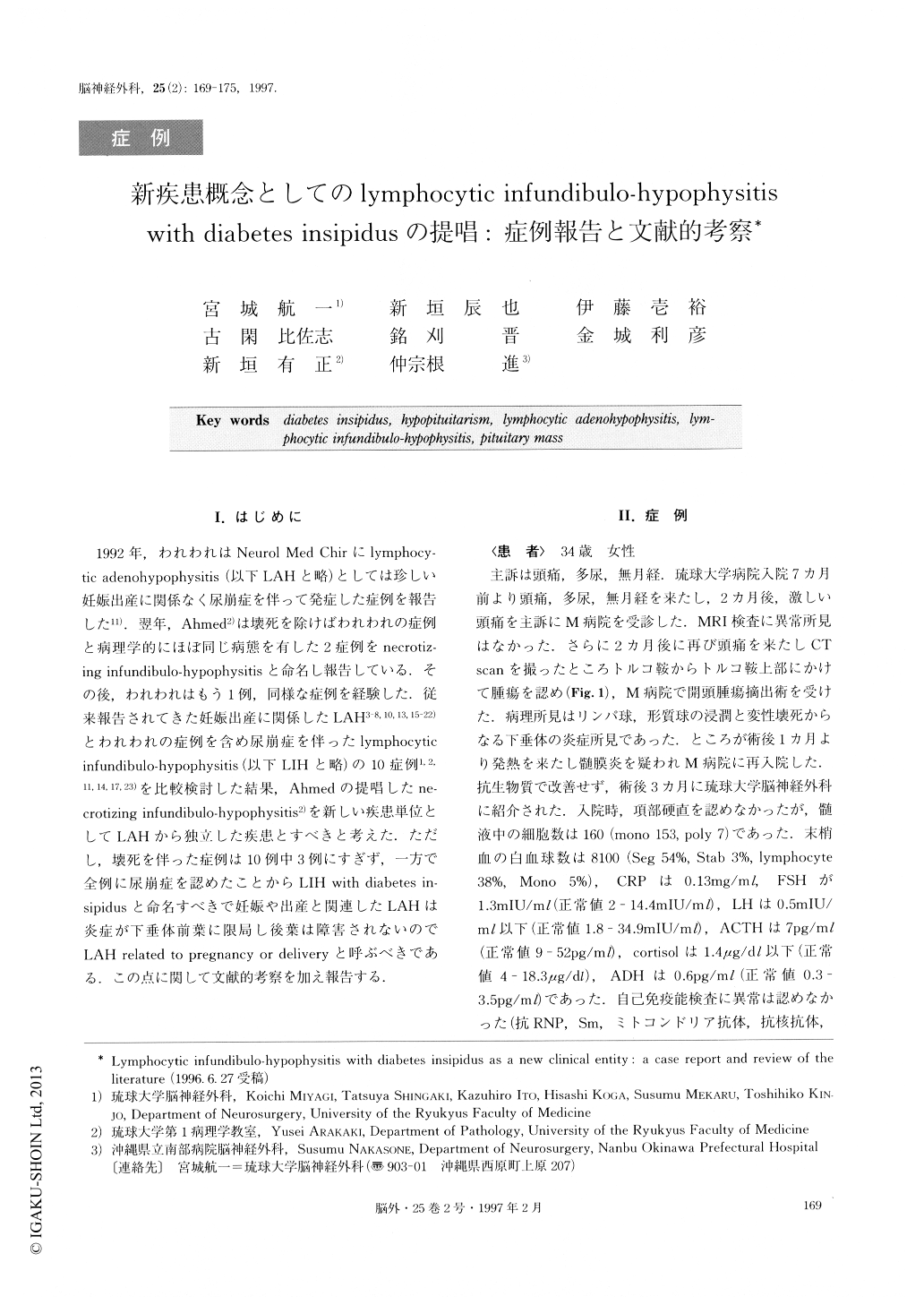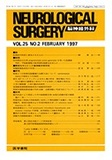Japanese
English
- 有料閲覧
- Abstract 文献概要
- 1ページ目 Look Inside
I.はじめに
1992年,われわれはNeurol Med Chirにlymphocy—tic adenohypophysitis(以下LAHと略)としては珍しい妊娠出産に関係なく尿崩症を伴って発症した症例を報告した11).翌年,Ahmed2)は壊死を除けばわれわれの症例と病理学的にほぼ同じ病態を有した2症例をnecrotiz—ing infundibulo-hypophysitisと命名し報告している.その後,われわれはもう1例,同様な症例を経験した.従来報告されてきた妊娠出産に関係したLAH3-8,10,13,15-22)とわれわれの症例を含め尿崩症を伴ったlymphocytic infundibulo-hypophysitis(以下LIHと略)の10症例1,2,11,14,17,23)を比較検討した結果,Ahmedの提唱したne—crotizing infundibulo-hypophysitis2)を新しい疾患単位としてLAHから独立した疾患とすべきと考えた.ただし,壊死を伴った症例は10例中3例にすぎず,一方で全例に尿崩症を認めたことからLIH with diabetes in—sipidusと命名すべきで妊娠や出産と関連したLAHは炎症が下垂体前葉に限局し後葉は障害されないのでLAH related to pregnancy or deliveryと呼ぶべきである.この点に関して文献的考察を加え報告する.
In 1992, we reported a lymphocytic adenohypophysi-tis (LIH) (Neurol Med Chir). We considered this case unusual in that the case was that of a menopausal female and that it was accompanied with diabetes insi-pidus as classical lymphocytic adenohypohysitis (LAH). Subsequently, Ahmed reported two cases which presented a similar pathological manifestation, except for necrosis, as did our case and named them “necrotizing infundibulo-hypophysitis.” Recently we en-countered another similar case, which is reported hereunder.
A female, 34 years of age, had suffered from head-ache, polyuria, and amenorrhea. CT scan showed a pituitary mass, and pituitary tumor was surgically re-moved transcranially at a local hospital. The patholo-gical examination revealed the findings of chronic in-flammation and necrosis. One month after the opera-tion, however, she was an in-patient again under the suspicion of meningitis for fever and, when antibiotic therapy at the local hospital resulted in no improve-ment, she was referred to our hospital. Endocrinological studies showed low FSH, LH, ACTH and plasma corti-sol level. Antibodies of serum to RNP, Sm, mitochon-dria, nucleus, AChR, and DNA were all negative. Be-cause of an intrasellar mass with suprasellar extension on MRI, transsphenoidal operation was conducted four months after the initial operation. The pathological ex-amination revealed the infiltration of lymphocytes, plas-ma cells, and foamy macrophages, and necrosis. After this operation, the headache was cured and the patient was discharged.
Two months subsequent to the second operation, headache recurred and temporal upper quadrantic anop-sia was noted. An enlarged tumor was found, but pre-dnisolone worked to cure the pain and the visual field defect was found to have been remedied. The patient's diabetes insipidus is presently persisting, and she still relies on the use of desmopressin acetate and is still in need of cortisol replacement therapy.
Including our cases, ten cases of lymphocytic hypophysitis, not related to pregnancy or delivery but with diabetes insipidus, have been reported. Several cli-nical and anatomical features distinguish these 10 cases from classical LAH. The classical LAH was predomi-nantly related to pregnancy or delivery. However 6 of 10 cases were male in LIH. LAH related to pregnancy or delivery does not accompany diabetes insipidus, but all reported cases of LIH had a diabetes insipidus. Visual field and/or ocular movement disturbance are LAH's chief complaints (15 out of 25 cases) but visual field disturbance seldom occurs in LIH (1 out of 10 cases). Hypopituitarism is more serious in LAH, and 4 cases became fatal from an adrenal crisis. Anatomically, in-flammatory change of LIH is located anterior and pos-terior to the pituitary gland and extends to the pituitary stalk and, at times, hypothalamus. On the other hand, LAH relates to pregnancy or delivery, the inflamma-tory change localizes to the adenohypophysis. Ahmed emphasized necrosis, while necrosis was not a prominent histological finding in LIH. Necrosis was noted only in 3 of 10 cases. To be stressed, rather, are the inflammatory changes seen on the neurohypophysis and the pituitary stalk, together with the characteristic diabetes insipidus. We believe, in view of the above, that what Ahmed named necrotizing infundi-bulo-hypophysitis should be named “LIH with diabetes insipidus.” Whereas differential diagnosis is necessary between this said new disorder and the conventional LAH, we advocate that the latter, which is related to pregnancy or parturition but is free from neurohypo-physitis be identified as “LAH related to pregnancy or delivery.”
With respect to treatment, steroid therapy is essen-tial. If the symptoms do not improve, a transsphenoidal operation for diagnosis (LIH and LAH) and decom-pression (the case of LAH with visual or external ocu-lar movement disturbance) is advisable. However, ex-tensive surgery is not recommended, because perma-nent damage of pituitary function is inevitable.

Copyright © 1997, Igaku-Shoin Ltd. All rights reserved.


